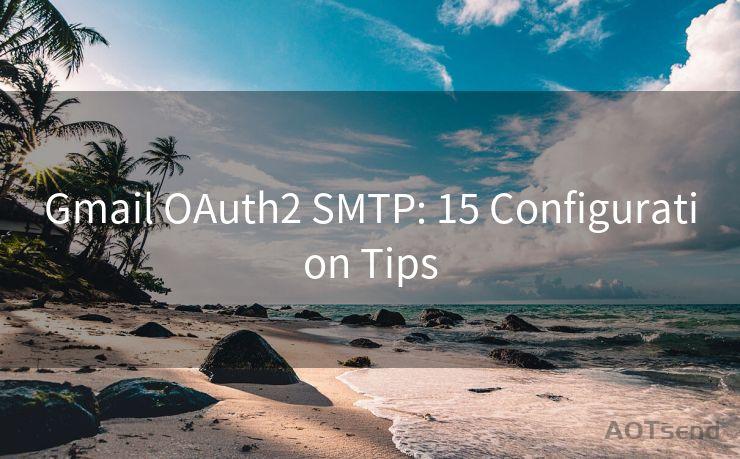Gmail OAuth2 SMTP: 15 Configuration Tips




When it comes to integrating Gmail with other applications or services using OAuth2 for SMTP authentication, there are several key configuration tips that can make the process smoother and more secure. In this article, we'll explore 15 essential tips to help you set up and manage your Gmail OAuth2 SMTP configuration effectively.
1. Understanding OAuth2 and Its Benefits
Before diving into the configuration, it's crucial to understand the benefits of using OAuth2 for SMTP authentication. OAuth2 provides a secure way to grant third-party applications access to your Gmail account without exposing your password.
2. Setting Up a Google Developer Project
To use OAuth2 with Gmail, you need to set up a project in the Google Developers Console. This involves creating credentials that your application will use to authenticate with Google's servers.
3. Choosing the Right Scopes
Scopes define the level of access your application requires from a user's Gmail account. It's important to request only the necessary scopes to minimize privacy concerns and increase user trust.
4. Implementing the OAuth2 Flow
The OAuth2 authentication flow involves several steps, including redirecting the user to Google's authorization server, handling the response, and exchanging the authorization code for an access token.
5. Managing Access Tokens and Refresh Tokens
Access tokens have a limited lifespan and need to be refreshed periodically. Implementing a mechanism to securely store and refresh these tokens is essential for maintaining uninterrupted access.
6. Configuring SMTP Settings
Once you have an access token, you can configure your SMTP client to use it for authentication. This typically involves setting the SMTP server address, port, and security options.
7. Handling Errors and Expirations

Be prepared to handle errors gracefully, such as expired access tokens or other authentication issues. Implementing proper error handling ensures a smooth user experience.
8. Securing Your Application
Protecting your application and user data is paramount. Use HTTPS for all communication, store sensitive information securely, and regularly update your dependencies to mitigate security risks.
🔔🔔🔔
【AOTsend Email API】:AOTsend is a Managed Email Service for sending transactional emails. Support Email Types: reminders, authentication, confirmations, notifications, verification codes, invoices, password resets, account activations, billing statements, two-factor authentication (2FA), and one-time passwords (OTP) emails, etc. $0.28 per 1000 Emails. 99% Delivery, 98% Inbox Rate.
You might be interested in:
Why did we start the AOTsend project, Brand Story?
What is a Managed Email API, How it Works?
Best 25+ Email Marketing Platforms (Authority,Keywords&Traffic Comparison)
Best 24+ Email Marketing Service (Price, Pros&Cons Comparison)
Email APIs vs SMTP: How they Works, Any Difference?
9. Testing and Debugging
Thoroughly test your OAuth2 SMTP integration in various scenarios to identify and resolve any potential issues. Utilize logging and debugging tools to diagnose problems effectively.
10. Monitoring and Logging
Implement monitoring and logging mechanisms to track the performance and any potential issues with your OAuth2 SMTP integration. This helps in identifying and resolving problems promptly.
11. Staying Up to Date with Google's Policies
Google's policies and APIs can change, so it's essential to stay updated. Subscribe to relevant Google Developer channels and monitor changes that may affect your integration.
12. Optimizing Performance
Optimize your application's performance by minimizing the number of API calls, caching data appropriately, and using asynchronous processing when possible.
13. Providing User Support
Prepare documentation and support resources to help users understand and troubleshoot any issues they may encounter with your OAuth2 SMTP integration.
14. Scaling and Maintainability
As your application grows, consider scalability and maintainability. Design your system to handle increasing user loads and simplify future updates or modifications.
15. Continuously Improving
Regularly review your OAuth2 SMTP integration, collect user feedback, and make improvements based on actual usage patterns and emerging best practices.
By following these 15 configuration tips, you can ensure a seamless and secure integration of Gmail OAuth2 SMTP into your application or service. Remember to prioritize security, performance, and user experience to create a robust and reliable solution.




Scan the QR code to access on your mobile device.
Copyright notice: This article is published by AotSend. Reproduction requires attribution.
Article Link:https://www.mailwot.com/p1236.html



